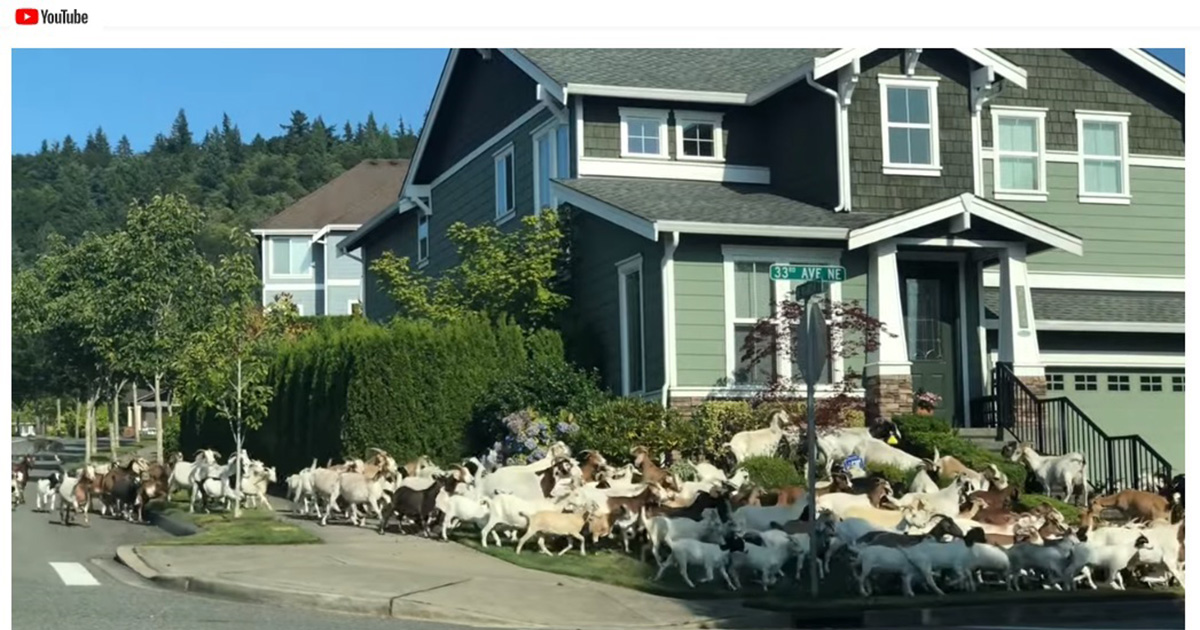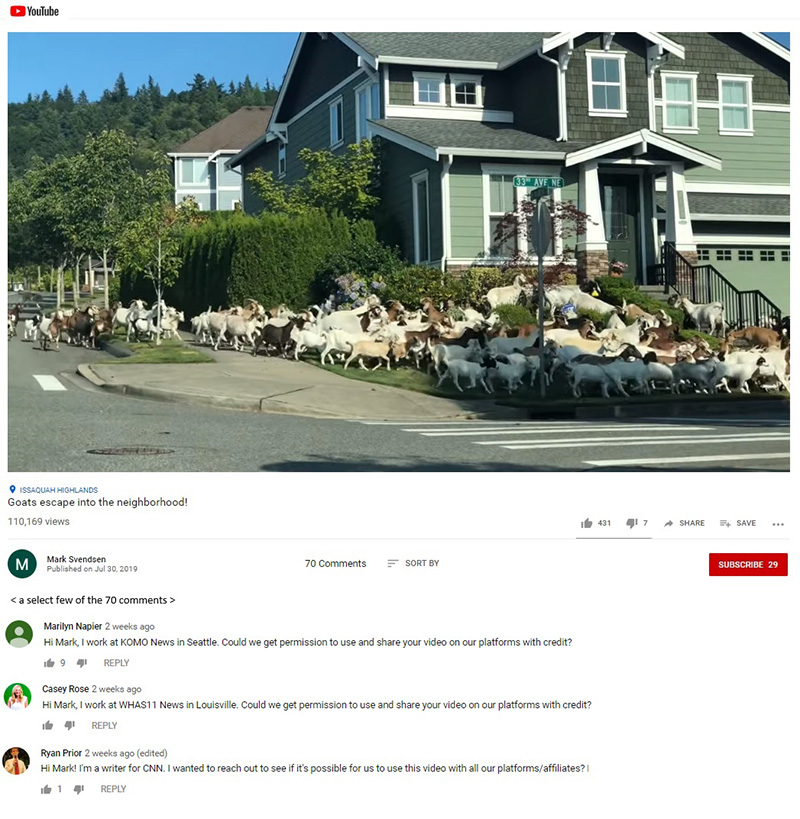
How one Issaquah Highlands couple made viral video fame
Issaquah Highlands’ Magnolia Park residents, Mark Svendsen and Helen Au-Svendsen quickly shot to video fame as their footage of the “Great Goat Escape” of July 2019 went viral online and on media channels around the world.
On July 30, 200 goats hired by the IHCA to assist with clearing vegetation clearing escaped from their enclosure in the Mulberry neighborhood when Mark and Helen drove by and captured the video. Their video of the goats running free through the front yards, and front porches, of the Mulberry neighborhood was an instant hit.
Mark posted the video twice on YouTube, once with and once without sound, accruing more than 120K views and more than 100 comments. Media outlets around the world clamored for permission to share Mark’s video.
We interviewed Mark via email to ask what it’s like to make viral video fame:
Were you aware goats were in your neighborhood working for the local landscape crew?
Of course. We went to greet them as soon as they arrived on our street on a Friday evening. Every year we look forward to the goats working between our back yard and the greenbelt. We feel privileged to have them next to our house for a few days every year.
What were you doing that evening when you saw the goats coming down the road?
We had just been driving home from work in Seattle and picked up our two kids from camp. My first reaction was that I had to stop the car to avoid hitting the goats. As I was just about to tell Helen to take a video, I noticed she was already on it.
What happened next?
After filming the video, we stopped the car and pondered how we could help. A group of ten goats took off down an alley so I ran after them and managed to herd them back to where Craig, the herder, was. I then went with Craig to try and locate the rest of them by following goat droppings on the street. I ended up running all around the neighborhood to help track them down.
After returning home an about an hour later after helping chase down the goats, I told Helen that I had to get a copy of that video because I thought it was newsworthy. She didn’t believe me but let me post it on YouTube if I removed the audio. I sent the version with audio to family and it was such a hit among them that they pleaded with us to share the version with sound.
 What was the first indication that your video was reaching more than just family and friends?
What was the first indication that your video was reaching more than just family and friends?
After posting it on YouTube, I shared it in a comment on the long Facebook post about the escape. I also posted it on Twitter, but I have only just over 200 followers. I didn’t try to promote the video at all. Seventeen hours after that is when the views shot up. It was posted to the Seattle Reddit forum at 11:00am the next morning, and that was probably a large factor in it getting a lot of attention. Midday, that post on Reddit had 700 upvotes, which is a lot for Seattle.
A few hours later in the middle of the night, a UK press agency asked to pay us to use the video, but I didn’t think much of it. Around noon the next day I got a call on my mobile phone from KIRO7 News asking for an interview to talk about the video. Helen also started getting calls on her phone around the same time. A few other news organizations called after that. It surprised us that they could all find our cell phone numbers so quickly.
When did you first realize your video had “gone viral”? How did you feel about that?
We looked at the views on the YouTube video and found they were obscenely high. Then comments started appearing on the YouTube video, Twitter, and Facebook messages asking for permission to use the video. Then companies who specialize in buying and selling viral videos started competing to get exclusive rights to market it and give us a cut.
That whole day of work and evening was busy for me, making it stressful dealing with all these requests. I tried to ignore them, but also wanted the video to be included with the news stories the local stations would be running. After messaging Helen, we decided not to worry about trying to negotiate payment for each use of the video and let most outlets use it for free. We also debated about the ethics of how the video would be used and whether it would be damaging to anyone, but concluded that it brought joy to everyone who watched it.
What was the most significant media outlet to ask to share your video?
Having the video appear on Good Morning America felt like the most significant outlet that shared it.
What is the most distant media outlet to ask to share your video?
Russia Times, The Independent (UK), and Fuji TV in Japan.
Did you see the video on all these channels?
I was too exhausted by the situation to turn on the TV. I did see some clips that others shared where the video aired on those channels. Though, having the clip and my name appear on Japanese TV was pretty special, since I lived in Japan as a teenager and studied Japanese for 10 years.
Did you charge for use of your video?
It was difficult because I felt like we were being taken advantage of by giving something valuable away for free. Otherwise, I would have had to take the day off to deal with negotiating payment and signing contracts. We don’t regret giving it away for free to local news, but we should have asked for payment from big media companies.
A week later, the A&E show Live Rescue requested use of the video, and I ignored it, but they persisted. I finally told them they couldn’t use it for free and they responded with an offer for payment, and we accepted.
If you could do the whole thing over again, would you do it differently?
I wish I would have taken some additional videos while helping to track down the goats and return them safely, especially knowing now that there was so much interest in what happened.
An abridged version of this story was published in September 2019 Connections






